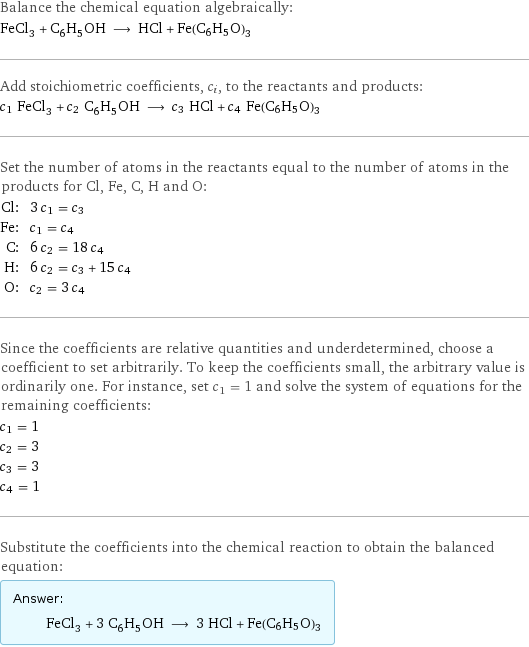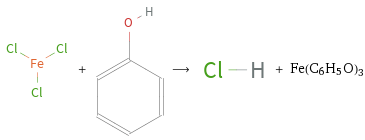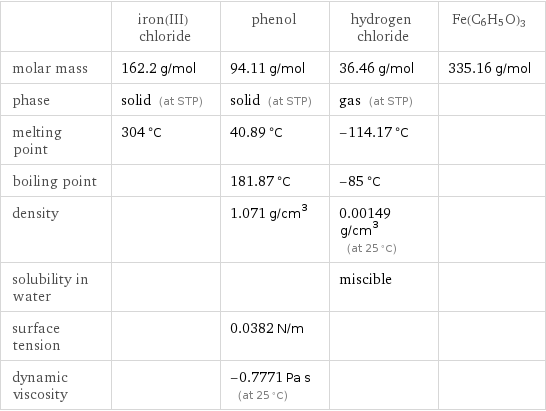Input interpretation

FeCl_3 iron(III) chloride + C_6H_5OH phenol ⟶ HCl hydrogen chloride + Fe(C6H5O)3
Balanced equation

Balance the chemical equation algebraically: FeCl_3 + C_6H_5OH ⟶ HCl + Fe(C6H5O)3 Add stoichiometric coefficients, c_i, to the reactants and products: c_1 FeCl_3 + c_2 C_6H_5OH ⟶ c_3 HCl + c_4 Fe(C6H5O)3 Set the number of atoms in the reactants equal to the number of atoms in the products for Cl, Fe, C, H and O: Cl: | 3 c_1 = c_3 Fe: | c_1 = c_4 C: | 6 c_2 = 18 c_4 H: | 6 c_2 = c_3 + 15 c_4 O: | c_2 = 3 c_4 Since the coefficients are relative quantities and underdetermined, choose a coefficient to set arbitrarily. To keep the coefficients small, the arbitrary value is ordinarily one. For instance, set c_1 = 1 and solve the system of equations for the remaining coefficients: c_1 = 1 c_2 = 3 c_3 = 3 c_4 = 1 Substitute the coefficients into the chemical reaction to obtain the balanced equation: Answer: | | FeCl_3 + 3 C_6H_5OH ⟶ 3 HCl + Fe(C6H5O)3
Structures

+ ⟶ + Fe(C6H5O)3
Names

iron(III) chloride + phenol ⟶ hydrogen chloride + Fe(C6H5O)3
Equilibrium constant
![Construct the equilibrium constant, K, expression for: FeCl_3 + C_6H_5OH ⟶ HCl + Fe(C6H5O)3 Plan: • Balance the chemical equation. • Determine the stoichiometric numbers. • Assemble the activity expression for each chemical species. • Use the activity expressions to build the equilibrium constant expression. Write the balanced chemical equation: FeCl_3 + 3 C_6H_5OH ⟶ 3 HCl + Fe(C6H5O)3 Assign stoichiometric numbers, ν_i, using the stoichiometric coefficients, c_i, from the balanced chemical equation in the following manner: ν_i = -c_i for reactants and ν_i = c_i for products: chemical species | c_i | ν_i FeCl_3 | 1 | -1 C_6H_5OH | 3 | -3 HCl | 3 | 3 Fe(C6H5O)3 | 1 | 1 Assemble the activity expressions accounting for the state of matter and ν_i: chemical species | c_i | ν_i | activity expression FeCl_3 | 1 | -1 | ([FeCl3])^(-1) C_6H_5OH | 3 | -3 | ([C6H5OH])^(-3) HCl | 3 | 3 | ([HCl])^3 Fe(C6H5O)3 | 1 | 1 | [Fe(C6H5O)3] The equilibrium constant symbol in the concentration basis is: K_c Mulitply the activity expressions to arrive at the K_c expression: Answer: | | K_c = ([FeCl3])^(-1) ([C6H5OH])^(-3) ([HCl])^3 [Fe(C6H5O)3] = (([HCl])^3 [Fe(C6H5O)3])/([FeCl3] ([C6H5OH])^3)](../image_source/0a13b8ea64e44024dad05ffe6313db28.png)
Construct the equilibrium constant, K, expression for: FeCl_3 + C_6H_5OH ⟶ HCl + Fe(C6H5O)3 Plan: • Balance the chemical equation. • Determine the stoichiometric numbers. • Assemble the activity expression for each chemical species. • Use the activity expressions to build the equilibrium constant expression. Write the balanced chemical equation: FeCl_3 + 3 C_6H_5OH ⟶ 3 HCl + Fe(C6H5O)3 Assign stoichiometric numbers, ν_i, using the stoichiometric coefficients, c_i, from the balanced chemical equation in the following manner: ν_i = -c_i for reactants and ν_i = c_i for products: chemical species | c_i | ν_i FeCl_3 | 1 | -1 C_6H_5OH | 3 | -3 HCl | 3 | 3 Fe(C6H5O)3 | 1 | 1 Assemble the activity expressions accounting for the state of matter and ν_i: chemical species | c_i | ν_i | activity expression FeCl_3 | 1 | -1 | ([FeCl3])^(-1) C_6H_5OH | 3 | -3 | ([C6H5OH])^(-3) HCl | 3 | 3 | ([HCl])^3 Fe(C6H5O)3 | 1 | 1 | [Fe(C6H5O)3] The equilibrium constant symbol in the concentration basis is: K_c Mulitply the activity expressions to arrive at the K_c expression: Answer: | | K_c = ([FeCl3])^(-1) ([C6H5OH])^(-3) ([HCl])^3 [Fe(C6H5O)3] = (([HCl])^3 [Fe(C6H5O)3])/([FeCl3] ([C6H5OH])^3)
Rate of reaction
![Construct the rate of reaction expression for: FeCl_3 + C_6H_5OH ⟶ HCl + Fe(C6H5O)3 Plan: • Balance the chemical equation. • Determine the stoichiometric numbers. • Assemble the rate term for each chemical species. • Write the rate of reaction expression. Write the balanced chemical equation: FeCl_3 + 3 C_6H_5OH ⟶ 3 HCl + Fe(C6H5O)3 Assign stoichiometric numbers, ν_i, using the stoichiometric coefficients, c_i, from the balanced chemical equation in the following manner: ν_i = -c_i for reactants and ν_i = c_i for products: chemical species | c_i | ν_i FeCl_3 | 1 | -1 C_6H_5OH | 3 | -3 HCl | 3 | 3 Fe(C6H5O)3 | 1 | 1 The rate term for each chemical species, B_i, is 1/ν_i(Δ[B_i])/(Δt) where [B_i] is the amount concentration and t is time: chemical species | c_i | ν_i | rate term FeCl_3 | 1 | -1 | -(Δ[FeCl3])/(Δt) C_6H_5OH | 3 | -3 | -1/3 (Δ[C6H5OH])/(Δt) HCl | 3 | 3 | 1/3 (Δ[HCl])/(Δt) Fe(C6H5O)3 | 1 | 1 | (Δ[Fe(C6H5O)3])/(Δt) (for infinitesimal rate of change, replace Δ with d) Set the rate terms equal to each other to arrive at the rate expression: Answer: | | rate = -(Δ[FeCl3])/(Δt) = -1/3 (Δ[C6H5OH])/(Δt) = 1/3 (Δ[HCl])/(Δt) = (Δ[Fe(C6H5O)3])/(Δt) (assuming constant volume and no accumulation of intermediates or side products)](../image_source/20bff7d98df059a5ea951fb6806d506b.png)
Construct the rate of reaction expression for: FeCl_3 + C_6H_5OH ⟶ HCl + Fe(C6H5O)3 Plan: • Balance the chemical equation. • Determine the stoichiometric numbers. • Assemble the rate term for each chemical species. • Write the rate of reaction expression. Write the balanced chemical equation: FeCl_3 + 3 C_6H_5OH ⟶ 3 HCl + Fe(C6H5O)3 Assign stoichiometric numbers, ν_i, using the stoichiometric coefficients, c_i, from the balanced chemical equation in the following manner: ν_i = -c_i for reactants and ν_i = c_i for products: chemical species | c_i | ν_i FeCl_3 | 1 | -1 C_6H_5OH | 3 | -3 HCl | 3 | 3 Fe(C6H5O)3 | 1 | 1 The rate term for each chemical species, B_i, is 1/ν_i(Δ[B_i])/(Δt) where [B_i] is the amount concentration and t is time: chemical species | c_i | ν_i | rate term FeCl_3 | 1 | -1 | -(Δ[FeCl3])/(Δt) C_6H_5OH | 3 | -3 | -1/3 (Δ[C6H5OH])/(Δt) HCl | 3 | 3 | 1/3 (Δ[HCl])/(Δt) Fe(C6H5O)3 | 1 | 1 | (Δ[Fe(C6H5O)3])/(Δt) (for infinitesimal rate of change, replace Δ with d) Set the rate terms equal to each other to arrive at the rate expression: Answer: | | rate = -(Δ[FeCl3])/(Δt) = -1/3 (Δ[C6H5OH])/(Δt) = 1/3 (Δ[HCl])/(Δt) = (Δ[Fe(C6H5O)3])/(Δt) (assuming constant volume and no accumulation of intermediates or side products)
Chemical names and formulas

| iron(III) chloride | phenol | hydrogen chloride | Fe(C6H5O)3 formula | FeCl_3 | C_6H_5OH | HCl | Fe(C6H5O)3 Hill formula | Cl_3Fe | C_6H_6O | ClH | C18H15FeO3 name | iron(III) chloride | phenol | hydrogen chloride | IUPAC name | trichloroiron | phenol | hydrogen chloride |
Substance properties

| iron(III) chloride | phenol | hydrogen chloride | Fe(C6H5O)3 molar mass | 162.2 g/mol | 94.11 g/mol | 36.46 g/mol | 335.16 g/mol phase | solid (at STP) | solid (at STP) | gas (at STP) | melting point | 304 °C | 40.89 °C | -114.17 °C | boiling point | | 181.87 °C | -85 °C | density | | 1.071 g/cm^3 | 0.00149 g/cm^3 (at 25 °C) | solubility in water | | | miscible | surface tension | | 0.0382 N/m | | dynamic viscosity | | -0.7771 Pa s (at 25 °C) | |
Units
